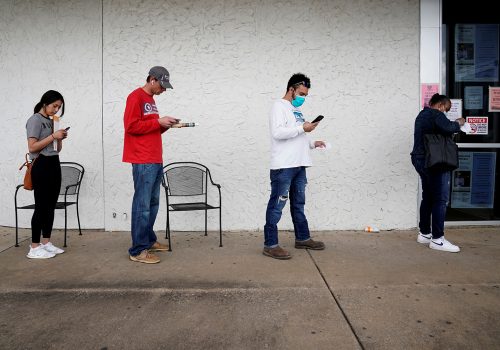US Economy: V shape or K shape recovery?
At last night’s presidential debate moderator Chris Wallace asked the candidates if we are in a ‘V’ shape or ‘K’ shape recovery. What does that mean exactly? A ‘V’ means a rapid rebound bringing economic activity back to its pre-COVID levels. A ‘K’ means an unequal recovery – wealthier Americans do well but poorer Americans remain stuck in recession.
So, what’s the answer? It’s complicated. The US economy is recovering quickly but many industries – and many people – are being left out. See our full analysis below to understand the dimensions of the recovery and compare the US situation to the rest of the world.
GDP
US Q2 GDP shrank nearly 10%, or 31.4% on an annualized basis. That places it right in line with Germany and slightly worse than Japan. The Q3 GDP estimate will be released on Oct. 29, five days before the presidential election. China, which emerged earlier from lockdown, has jumped ahead in the race for growth.
Note: All these graphs are interactive. Hovering over the graphs reveals details. By clicking on the variables in the legend, they can be removed or added to your liking.
Unemployment
Unemployment in the US remain higher than most other advanced economies. Current overall unemployment rate in the US is 8.4%. Youth unemployment is particularly high in the US at 14.7%, raising questions about the long-term economic impact for those that struggle to find work at the beginning of their careers.
Fiscal Response
Total US fiscal spending to date amounts to nearly 14% of US GDP. That puts it near the top of G20 countries in terms of economic firepower deployed to combat the crisis. As our analysis shows, this is significantly money spent as a percentage of GDP than during the Global Financial Crisis. However, as many other countries at preparing new stimulus packages to handle the continuing fallout from COVID-19, the US has no immediate plans for more fiscal relief.
State Tax Revenue
State tax revenues took a major hit at the onset of the crisis, however some states are seeing a faster than expected pick up as lockdowns ease. New York and California, the two largest drivers of US GDP, are still expecting major budget shortfalls this year.
Inflation
Across the major advanced economies, inflation has remained subdued both before and during the crisis. The Fed’s easy monetary policy and new stance on inflation targeting is designed to change this dynamic in the coming years. This may mean higher prices for consumers, but likely not until 2022.
Within the US, the economic crisis is not impacting everyone equally. Women and minorities are being particularly hard hit. For more on these inequities read Senior Fellow Nicole Goldin’s recent work:


Follow us on social media